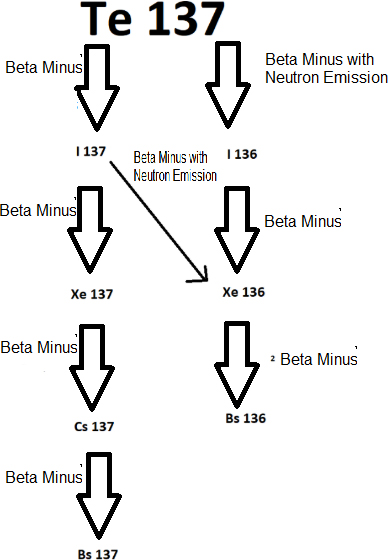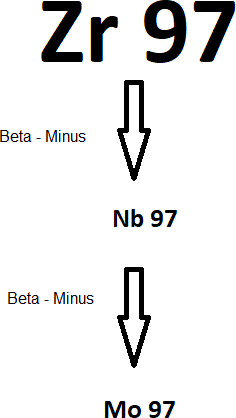
Concept explainers
a) Interpretation:
The total estimated mass Zr and Te disposed as nuclear waste by the nuclear technician
Concept Introduction:
(uranium) undergoes a fission reaction which is neutron induced. On doing so, it will split into two smaller nuclei
(zirconium) and (tellurium). In the process, neutrons and gamma rays are released. The
Answer to Problem 14.59PAE
Solution:
3.231 metric ton
Explanation of Solution
The total amount of electrical energy generated by all the nuclear reactors is
From the problem 14.55, we know the amount of energy released during the fission of 1 kg of is
Hence,
Total mass of used =
For every fission of 236.133 grams of , 233.83627 grams of nuclear waste is generated.
Hence, the total estimated mass of Zr and Te (which are the products of fission of ) disposed as nuclear waste is
(b) Interpretation:
Whether any of the products Zr and Te obtained from the fission of
are available in measurable quantities in the nuclear waste
Concept Introduction: (uranium) undergoes a fission reaction which is neutron induced. On doing so, it will split into two smaller nuclei (zirconium) and (tellurium). In the process, neutrons and gamma rays are released. The nuclear equation for this reaction is as follows:
Answer to Problem 14.59PAE
Solution:
Only a measurable quantity of Zr will be left in the waste
Explanation of Solution
The half life of is 16.749 hours. The half life of is 2.49 seconds. As would undergo Beta-minus decay, it would get degraded within 2.49 seconds whereas Zr having larger half life will be present in measurable quantities.
(c) Interpretation:
Decay series of each isotope and
Concept Introduction: (uranium) undergoes a fission reaction which is neutron induced. On doing so, it will split into two smaller nuclei (zirconium) and (tellurium). In the process, neutrons and gamma rays are released. The nuclear equation for this reaction is as follows:
Answer to Problem 14.59PAE
Solution:
The decay series for Te
Explanation of Solution
The decay series of is

The decay series of is

The decay series of has Cs 137 which will remain in waste for many years.
(d) Interpretation:
The difference between the total mass of the waste using the stable isotope products and the technician’s estimated total mass.
Concept Introduction: (uranium) undergoes a fission reaction which is neutron induced. On doing so, it will split into two smaller nuclei (zirconium) and (tellurium). In the process, neutrons and gamma rays are released. The nuclear equation for this reaction is as follows:
Answer to Problem 14.59PAE
Solution:
The technician’s estimates of total waste were off by 0.079751 kg.
Explanation of Solution
Mass of the stable isotope products =
Mass of the waste so obtained = kg or 3.2309273 metric ton
The difference between the technician’s estimated mass and the above calculated mass is
Want to see more full solutions like this?
Chapter 14 Solutions
CHEM FOR ENGNRNG SDNTS (EBOOK) W/ACCES
- Using reaction free energy to predict equilibrium composition Consider the following equilibrium: 2NO2 (g) = N2O4(g) AGº = -5.4 kJ Now suppose a reaction vessel is filled with 4.53 atm of dinitrogen tetroxide (N2O4) at 279. °C. Answer the following questions about this system: Under these conditions, will the pressure of N2O4 tend to rise or fall? Is it possible to reverse this tendency by adding NO2? In other words, if you said the pressure of N2O4 will tend to rise, can that be changed to a tendency to fall by adding NO2? Similarly, if you said the pressure of N2O4 will tend to fall, can that be changed to a tendency to '2' rise by adding NO2? If you said the tendency can be reversed in the second question, calculate the minimum pressure of NO 2 needed to reverse it. Round your answer to 2 significant digits. 00 rise ☐ x10 fall yes no ☐ atm G Ar 1arrow_forwardWhy do we analyse salt?arrow_forwardCurved arrows are used to illustrate the flow of electrons. Using the provided starting and product structures, draw the curved electron-pushing arrows for the following reaction or mechanistic step(s). Be sure to account for all bond-breaking and bond-making steps. H H CH3OH, H+ H Select to Add Arrows H° 0:0 'H + Q HH ■ Select to Add Arrows CH3OH, H* H. H CH3OH, H+ HH ■ Select to Add Arrows i Please select a drawing or reagent from the question areaarrow_forward
- What are examples of analytical methods that can be used to analyse salt in tomato sauce?arrow_forwardA common alkene starting material is shown below. Predict the major product for each reaction. Use a dash or wedge bond to indicate the relative stereochemistry of substituents on asymmetric centers, where applicable. Ignore any inorganic byproducts H Šali OH H OH Select to Edit Select to Draw 1. BH3-THF 1. Hg(OAc)2, H2O =U= 2. H2O2, NaOH 2. NaBH4, NaOH + Please select a drawing or reagent from the question areaarrow_forwardWhat is the MOHR titration & AOAC method? What is it and how does it work? How can it be used to quantify salt in a sample?arrow_forward
- Predict the major products of this reaction. Cl₂ hv ? Draw only the major product or products in the drawing area below. If there's more than one major product, you can draw them in any arrangement you like. Be sure you use wedge and dash bonds if necessary, for example to distinguish between major products with different stereochemistry. If there will be no products because there will be no significant reaction, just check the box under the drawing area and leave it blank. Note for advanced students: you can ignore any products of repeated addition. Explanation Check Click and drag to start drawing a structure. 80 10 m 2025 McGraw Hill LLC. All Rights Reserved. Terms of Use | Privacy Center | Accessibility DII A F1 F2 F3 F4 F5 F6 F7 F8 EO F11arrow_forwardGiven a system with an anodic overpotential, the variation of η as a function of current density- at low fields is linear.- at higher fields, it follows Tafel's law.Calculate the range of current densities for which the overpotential has the same value when calculated for both cases (the maximum relative difference will be 5%, compared to the behavior for higher fields).arrow_forwardUsing reaction free energy to predict equilibrium composition Consider the following equilibrium: N2 (g) + 3H2 (g) = 2NH3 (g) AGº = -34. KJ Now suppose a reaction vessel is filled with 8.06 atm of nitrogen (N2) and 2.58 atm of ammonia (NH3) at 106. °C. Answer the following questions about this system: rise Under these conditions, will the pressure of N2 tend to rise or fall? ☐ x10 fall Is it possible to reverse this tendency by adding H₂? In other words, if you said the pressure of N2 will tend to rise, can that be changed to a tendency to fall by adding H2? Similarly, if you said the pressure of N will tend to fall, can that be changed to a tendency to rise by adding H₂? If you said the tendency can be reversed in the second question, calculate the minimum pressure of H₂ needed to reverse it. Round your answer to 2 significant digits. yes no ☐ atm Х ด ? olo 18 Ararrow_forward
 Chemistry: Principles and PracticeChemistryISBN:9780534420123Author:Daniel L. Reger, Scott R. Goode, David W. Ball, Edward MercerPublisher:Cengage Learning
Chemistry: Principles and PracticeChemistryISBN:9780534420123Author:Daniel L. Reger, Scott R. Goode, David W. Ball, Edward MercerPublisher:Cengage Learning Chemistry: Principles and ReactionsChemistryISBN:9781305079373Author:William L. Masterton, Cecile N. HurleyPublisher:Cengage Learning
Chemistry: Principles and ReactionsChemistryISBN:9781305079373Author:William L. Masterton, Cecile N. HurleyPublisher:Cengage Learning ChemistryChemistryISBN:9781305957404Author:Steven S. Zumdahl, Susan A. Zumdahl, Donald J. DeCostePublisher:Cengage Learning
ChemistryChemistryISBN:9781305957404Author:Steven S. Zumdahl, Susan A. Zumdahl, Donald J. DeCostePublisher:Cengage Learning Chemistry: An Atoms First ApproachChemistryISBN:9781305079243Author:Steven S. Zumdahl, Susan A. ZumdahlPublisher:Cengage Learning
Chemistry: An Atoms First ApproachChemistryISBN:9781305079243Author:Steven S. Zumdahl, Susan A. ZumdahlPublisher:Cengage Learning Chemistry: Matter and ChangeChemistryISBN:9780078746376Author:Dinah Zike, Laurel Dingrando, Nicholas Hainen, Cheryl WistromPublisher:Glencoe/McGraw-Hill School Pub Co
Chemistry: Matter and ChangeChemistryISBN:9780078746376Author:Dinah Zike, Laurel Dingrando, Nicholas Hainen, Cheryl WistromPublisher:Glencoe/McGraw-Hill School Pub Co





